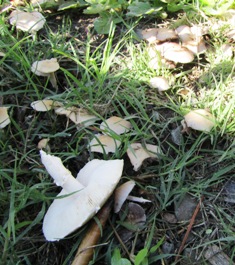Managing Rose Rust
I found rust on the undersides of leaves on some of my hybrid tea and floribunda roses while strolling around the farmette this morning. Usually by this time of year I have plucked off all the old leaves and cut the canes down to between 12 and 18 inches. The cutting back of hybrid teas and floribundas is necessary since those rose bushes produce flowers on new growth. Removing the leaves and cutting out the dead wood as well as pruning back the canes this time of year (end of December) encourages dormancy. I’m just now getting around to doing these chores.
Removing the foliage and destroying disease-infected leaves is a must. Do not put these in your compost pile. I keep a little bag next to me when I’m working with the roses in case I find evidence of rust or powdery mildew or black spot. Wind, rain, and overhead watering can spread the spores of these diseases. Destroying the leaves ensures that the plant gets a new start in the spring and that diseases cannot winter over on the foliage.
Rust most often appears on roses when the plant has moisture on its leaves for several hours. The rust infection looks like orange or yellow spots on the underside of the leaf. Eventually, it can migrate to the topside of the leaf as well. Leaves infected with rust will discolor and drop to the ground.
The long term solution to dealing with rust is to use drip irrigation or a soaker and to avoid overhead watering of your roses. As soon as you noticed rust, black spot, or mildew, remove and destroy any infected leaves and stems. Clean beneath the base of each plant and mulch with organic materials. That way, come spring your rose can start anew, producing strong canes, healthy leaves, and gorgeous blooms.
Is It a Mushroom, Morel, Truffle, or Toadstool?
I wouldn’t call myself a gastronome when it comes to mushrooms–my taste and enjoyment of them is not that discriminating. I like them in food, but I am not fond of finding them popping up all over the farmette after a rain. My displeasure at seeing them in the lawn, around the raised planter boxes, on the pathways, or in the orchard and garden stems from my not readily knowing which types are beneficial s and which are harmful. There are literally hundreds of different species, some are poisonous.
The mushroom (often called a toadstool) is the visible sign of the presence of a fungus in the soil. The toadstool generally has three parts–a stalk or stem, a cap, and gills. You might think of the hookah-smoking caterpillar perched on top of one in Alice’s Adventures in Wonderland, by English author Lewis Carroll.
Mushroom color varies with the species of fungus that produces the fruiting body. While many have neutral coloring, some, like the poisonous fly agaric (Amanita muscaria) that you would find in the woods associated with conifer and birch trees, has a brilliant red cap with white scales.
Don’t eat mushrooms or toadstools you find growing in the wild unless you are an expert on fungi.
The majority of fungi won’t harm the garden (although some do). If I don’t recognize the type of fungi that is growing, I either ignore them or use a spade to dig them out. I dispose of them in the garbage. Some toadstools are actually beneficial to the soil, adding back in certain nutrients. Such fungi have a symbiotic relationship with garden plants. However, others can have spores harmful to humans.
I’ve used a lot of soil amendment and compost on the property. There may be pieces of rotting wood buried under the dirt. Fungi need a food source to grow. In packed soil and the damp conditions following a rain, toadstools pop up, seemingly everywhere.
Alas, I cannot as yet tell the toadstool from the truffle or morel, so highly desired in the French and English culinary traditions, so I won’t eat any of them. And as for sitting on one, well . . . I leave that for the hairy worm of Lewis Carroll’s imagination.
 Facebook
Facebook Goodreads
Goodreads LinkedIn
LinkedIn Meera Lester
Meera Lester Twitter
Twitter






